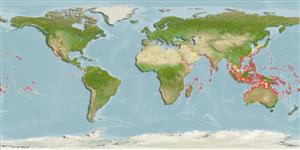Teleostei (teleosts) >
Acanthuriformes (Surgeonfishes) >
Acanthuridae (Surgeonfishes, tangs, unicornfishes) > Nasinae
Etymology: Naso: Latin, nasus = nose (Ref. 45335).
More on author: Cuvier.
Environment: milieu / climate zone / depth range / distribution range
Ecology
Marine; reef-associated; depth range 2 - 40 m (Ref. 48637), usually 10 - ? m. Tropical
Indo-Pacific: East Africa to Micronesia (excluding the Marshall Islands), north to the Ryukyu Islands, south to the Solomon Islands and the Great Barrier Reef. Range extending to Rangiroa Atoll, Tuamotu Archipelago.
Size / Weight / Age
Maturity: Lm ? range ? - ? cm
Max length : 40.0 cm FL male/unsexed; (Ref. 9710); common length : 25.0 cm FL male/unsexed; (Ref. 9710)
Dorsal spines (total): 4; Dorsal soft rays (total): 28 - 30; Anal spines: 2; Anal soft rays: 27 - 29. Body elongate-ovate. Dorsal and anal profiles nearly even. Forehead without rostral prominence when in adults. Peduncular plate single, with a semicircular, retrorsely curved keel. Reaches 35 cm SL.
Generally uncommon species found in steep outer lagoon and seaward reef slopes (Ref. 9710, 48637). Maximum depth reported at 40m (Ref. 37792) Occurs singly or in large schools (Ref. 9710, 48637). Usually seen swimming steadily along upper edges of drop-offs in pursuit of plankton (Ref. 48637). A semi-pelagic fish that feeds on zooplankton, but remains over or near reefs. Also feeds on algae (Ref. 30573). It is cleaned by Labroides and sleeps on reefs at night, taking on a disruptive mottled pattern (Ref. 10671). Caught with nets (Ref. 30573).
Life cycle and mating behavior
Maturity | Reproduction | Spawning | Eggs | Fecundity | Larvae
Randall, J.E., 1994. Unicornfishes of the subgenus Axinurus Perciformes: Acanthuridae: Naso), with description of a new species. Copeia 1994(1):116-124. (Ref. 10671)
IUCN Red List Status (Ref. 130435: Version 2024-1)
Threat to humans
Harmless
Human uses
Fisheries: commercial; aquarium: commercial
Tools
Special reports
Download XML
Internet sources
Estimates based on models
Preferred temperature (Ref.
123201): 24.7 - 29, mean 27.7 °C (based on 470 cells).
Phylogenetic diversity index (Ref.
82804): PD
50 = 0.5000 [Uniqueness, from 0.5 = low to 2.0 = high].
Bayesian length-weight: a=0.02188 (0.01261 - 0.03794), b=3.06 (2.91 - 3.21), in cm total length, based on LWR estimates for this species & Genus-body shape (Ref.
93245).
Trophic level (Ref.
69278): 3.0 ±0.32 se; based on food items.
Resilience (Ref.
120179): Medium, minimum population doubling time 1.4 - 4.4 years (Preliminary K or Fecundity.).
Fishing Vulnerability (Ref.
59153): Low to moderate vulnerability (34 of 100).
Nutrients (Ref.
124155): Calcium = 42.7 [26.3, 73.0] mg/100g; Iron = 0.552 [0.287, 0.947] mg/100g; Protein = 19 [18, 20] %; Omega3 = 0.139 [0.094, 0.248] g/100g; Selenium = 31 [18, 49] μg/100g; VitaminA = 70.4 [28.1, 175.2] μg/100g; Zinc = 1.3 [0.9, 1.8] mg/100g (wet weight);
